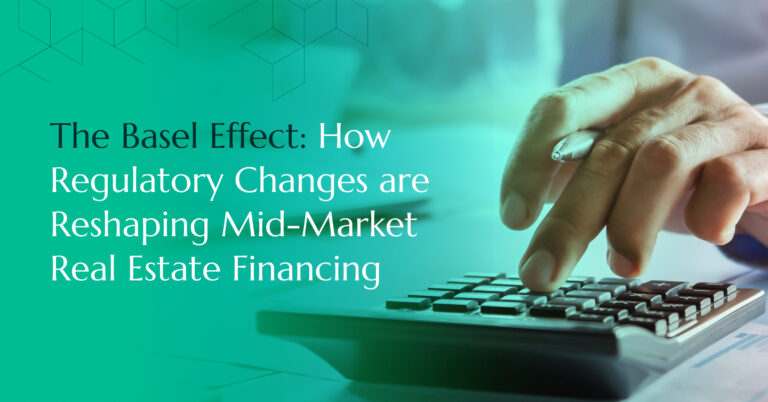In an era where global supply chains are being redrawn by politics as much as economics, tariffs have re-emerged as a potent force, and mid-market real estate in Northern Europe is squarely in the crosshairs. Developers from Hamburg to Helsinki are now grappling with soaring input costs, squeezed timelines, and funding uncertainty. Materials like steel and cement are becoming costlier and less predictable to source – tightening timelines and straining margins.
These shifts bring new layers of risk and complexity to traditional lenders, but they open the door for private credit. Agile, locally rooted, and structurally flexible, private lenders are increasingly stepping in where banks are pulling back, providing tailored capital just as the sector needs it most.
Tariffs in real estate: The direct and indirect impact
The rebalancing of global trade is underway, with the US leading the tariff war, but many countries are fighting back. While the broader economic impact will take time to unfold, tariffs are already reshaping the dynamics of real estate lending in identifiable ways.
Material cost inflation
After years of fighting, the introduction of tariffs has already had a significant impact on building materials such as steel, glass, and timber. Recent market data suggests that the price of HRC steel has surged by approximately 30% year-to-date in 2025, driven by rising input costs and tariff pressures. Timber, in particular cross-laminated timber used in ESG-aligned builds, has increased in price with further increases predicted. This is especially relevant for sustainable projects in Scandinavia, but this is a growing global market.
When you also consider “regular” inflation, which impacts the cost of living, wages, and ultimately consumer spending, developers are under increasing pressure.
Delayed timelines
There are already signs that many real estate projects are being pushed back due to material availability or pricing renegotiations. Uncertainty is the nemesis of any investment market, and this is no different when it comes to real estate development. This uncertainty, as well as the direct tariffs, has contributed to a slowdown in supply chains across Eastern Europe, Asia, and the UK.
Real estate and construction are prominent elements of the global and local economies, as the recent Spring Statement by the UK government demonstrated.
Risk redistribution
Traditional lenders were already struggling to adapt to Basel regulations, but the introduction of tariffs is making it even more difficult to forecast potential return on investment. The greater the uncertainty, the higher the lending premium, which has an obvious knock-on effect on projects and individual developer finances.
While the real estate sector, especially development, is experiencing broadly uncertain times, demand for asset-backed lending continues to rise.
Challenging times
Whether companies, individuals, or governments, challenges over the last twenty years have weakened and, in some cases, decimated balance sheets. A shift in the balance of trade, dictated by tariffs and counter-tariffs, will further undermine finances with a clear risk of contagion. As we saw with the US banking crisis just a few years ago, markets tend to exploit systemic vulnerabilities, often triggering broader stress across credit ecosystems.
Germany and Scandinavia: Where the pain is most acute
Amid renewed focus on U.S. tariff policies and political rhetoric, it’s essential to realise that concerns regarding tariffs have, to a lesser extent, always been in the background. In times of economic challenge, some countries and organisations, such as the EU, will “pull up the drawbridge” and protect their markets. In some ways, an ongoing increase in US tariffs simply highlights what has always been an underlying risk.
Germany’s supply chain sensitivity
The German real estate sector began to show signs of recovery in the final quarter of 2024, but recent developments have not been helpful. The real estate development sector is highly dependent on global material imports for projects such as commercial logistics parks. Prolonged uncertainty could prompt a domino effect, as real estate lending tightens and developers face wafer-thin margins, bringing activity to a halt.
Scandinavia’s Green Premium dilemma
As we alluded to earlier, there is renewed pressure on ESG-friendly building supplies and those used in sustainable projects. This will have a material impact on Sweden and Denmark despite the relevant governments’ growing policy and financial support. While unlikely, we may see a situation where difficulties with sustainable projects could lead developers to temporarily prioritise conventional builds over ESG-aligned models driven by unavoidable cost recalibrations.
Many observers believe that markets are pricing in a worst-case scenario as a consequence of this uncertainty. The reality is, even a best-case scenario will lead to a significant increase in costs, delays and real estate project cancellations.
How private credit is stepping into the void
We have seen significant growth in the private credit market in recent years, with many observers suggesting much more to come. Private credit’s adaptability and resilience in a relatively complex landscape make it ideal for those seeking finance. While it would be simplistic to frame this as a carte blanche opportunity for private credit investors, there is undoubtedly scope to secure attractive long-term asset-backed arrangements.
Flexible structure
The private credit sector is not subject to the regulation-heavy environment in which traditional lenders operate. Consequently, investors are able to take a creative approach to bespoke projects, including elements such as:-
- Bridge to core investment
- Bullet repayment models
- Phased distributions
This flexibility allows real estate developers to maximise assets while protecting expected pressure on short to medium-term cash flow. Interestingly, while the majority of private credit investors favour fixed-rate, fixed-term arrangements, there is also a growing use of benchmarked floating-rate instruments.
Risk sharing and collateralisation
As a consequence of regulatory changes, many traditional lenders are looking to sell on the more risky elements of their loan books. This will free up significant capital that is likely to focus on larger projects with enhanced headroom. Consequently, private lenders are now looking towards asset-backed deals with relatively conservative LTVs in the region of 50% to 70%.
Where there is significant collateral, private credit investors are more willing to consider mezzanine and subordinated positions, which carry a greater risk than the senior elements.
Localised origination
Private investors continue to support the lower end of the European real estate sector, where finance requirements rarely exceed €10 million. The higher end, above €50 million, is dominated by institutions looking for “less risky” exposure. This leaves the midmarket underfunded, with many developers struggling to raise new funds and refinance existing arrangements.
Localised origination is the key to this area; private credit lenders with boots on the ground can underwrite quickly, navigate permits, and reassess capital stacks in real-time. Cross-border flexibility also gives private credit lenders an advantage over domestic banks, which are often constrained by regulations and unhelpful national policies.
Market outlook
Those who follow the private credit market will not be surprised to learn of significant gains in recent years against traditional lenders. The PitchBook 2025 Outlook also paints an optimistic picture for private credit in the short to medium term. Many providers are returning to their original habitat – the middle market – as syndicated (less risky) finance dominates the higher end.
Lending strategy shifts in a tariff-influenced economy
Since the turn of the century, there have been numerous instances of equity market volatility, prompting many high-net-worth individuals to reconsider their investment strategies. The ongoing issue with tariffs is just one of many markets facing, with some investors now looking towards more conservative strategies. Private credit is now a core multi-trillion-dollar asset class in its own right.
While competition and pressure within the private credit sector may be prompting some to move beyond historical risk/reward ratios, it is critical that investors maintain a selective approach.
Tighter due diligence
Even though asset-backed lending offers a degree of security, it is still important to stress test borrower assumptions in relation to material costs, timelines, and exit cap rates. The use of cutting-edge AI models allows private credit investors to consider a range of scenarios and potential knock-on effects. Perhaps better prepared as a consequence, it is vital everyone remains vigilant.
Floating vs Fixed Rates
Contrary to what you may expect in a low-growth economic environment, an increase in tariffs is likely to push inflation higher in the short term. Consequently, some private credit investors are now looking towards floating-rate structures, which will protect them from short-term macro shifts. However, fixed-rate fixed-term arrangements are still the most popular, with asset-backed lending providing a welcome safety net in difficult times.
This shift reinforces the value of flexibility in structuring particularly in sectors where tariff exposure compounds construction risk.
Regional hedging
Broadly speaking, few, if any, countries in the world will escape tariff increases, although they will be impacted to varying degrees. This has prompted talk of “regional hedging”, with private credit lending likely to be more available in less tariff-exposed markets. We are also likely to see a preference for logistics and multi-use assets over what can be capital-intensive traditional residential projects.
What this means for investors
Emerald Peak is managed by an experienced team with particular expertise in midmarket European real estate lending. This area has been underfunded and overexposed for some time, providing opportunities for double-digit returns. Traditional lenders were already adjusting their exposure as a consequence of Basel regulations, but the ongoing uncertainty regarding tariffs has injected an unwelcome additional degree of risk into their assets.
Taking a broader view, the resilience of private credit lies in its ability to move quickly and structure risk in creative ways. As a borrower, it’s important to partner with a lender that understands real estate fundamentals, economic challenges, and growing tariff risk. While asset-backed lending provides a degree of security to private credit investors, it also helps to restrict upside pressure on borrowing costs. The lender will have asset backing while the borrower secures finance that may otherwise be unavailable.
Average risk-adjusted returns are increasing due to growing volatility and uncertainty, even though conservative lending ratios provide strong support.
Conclusion: Disruption to Opportunity
Tariff-driven volatility isn’t a passing phase; it’s a new layer of complexity in Northern Europe’s real estate landscape. Private credit stands out in this environment for its agility, creativity, and local expertise.
At Emerald Peak, we specialise in navigating these challenges with tailored, asset-backed solutions that bridge funding gaps left by traditional lenders and complex markets. Our disciplined underwriting, regional networks, and focus on sustainable growth make us a trusted partner in turbulent times. For investors and developers alike, in an uncertain world, choosing a capital partner that sees volatility as an opportunity isn’t just strategic; it’s imperative.
To explore how Emerald Peak can help navigate tariff-driven volatility and uncover midmarket real estate opportunities, contact us for a bespoke strategy review.



